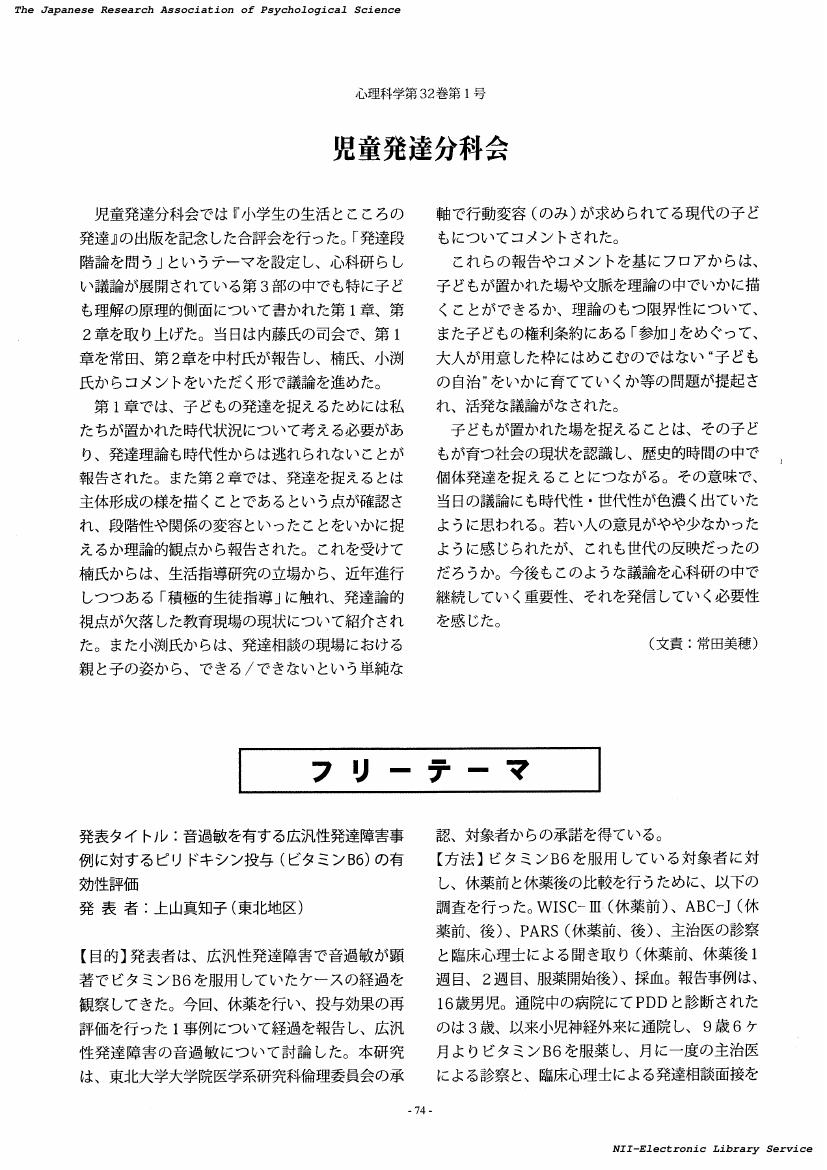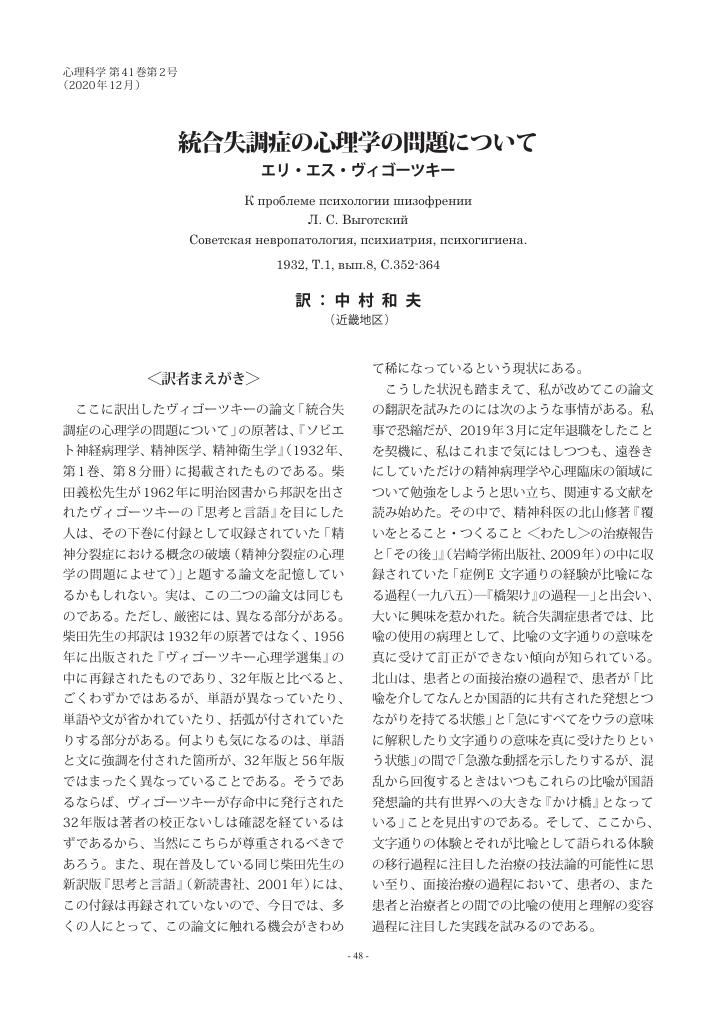1 0 0 0 OA 今日の学校教育制度と人間観・発達観(<特集>心理学は教育の目標をどうとらえるか)
- 著者
- 都筑 学
- 出版者
- 心理科学研究会
- 雑誌
- 心理科学 (ISSN:03883299)
- 巻号頁・発行日
- vol.34, no.1, pp.1-10, 2013-06-23 (Released:2017-09-10)
- 著者
- 近藤 龍彰
- 出版者
- 心理科学研究会
- 雑誌
- 心理科学 (ISSN:03883299)
- 巻号頁・発行日
- vol.42, no.2, pp.45-56, 2021 (Released:2022-05-11)
- 参考文献数
- 5
- 著者
- 上山 真知子
- 出版者
- 心理科学研究会
- 雑誌
- 心理科学 (ISSN:03883299)
- 巻号頁・発行日
- vol.32, no.1, pp.74-75, 2011-06-20 (Released:2017-09-10)
1 0 0 0 OA 精神医療における心理療法についての一考察
- 著者
- 田中 詔子
- 出版者
- 心理科学研究会
- 雑誌
- 心理科学 (ISSN:03883299)
- 巻号頁・発行日
- vol.42, no.1, pp.14-19, 2021 (Released:2021-08-04)
- 参考文献数
- 21
- 著者
- 佐野 修吉
- 出版者
- 心理科学研究会
- 雑誌
- 心理科学 (ISSN:03883299)
- 巻号頁・発行日
- vol.30, no.1, pp.1-10, 2009-10-30 (Released:2017-09-10)
- 被引用文献数
- 1
1 0 0 0 OA 幼児期における時間的拡張自己と「心の理論」 : 時間的視点からの理論的考察
- 著者
- 木下 孝司
- 出版者
- 心理科学研究会
- 雑誌
- 心理科学 (ISSN:03883299)
- 巻号頁・発行日
- vol.25, no.1, pp.58-73, 2005-02-28 (Released:2017-09-10)
- 被引用文献数
- 2
Research on theory of mind has increased for the last twenty years. Many researchers have refined on the "false belief" task in order to demonstrate that younger children can understand the representational mind. Nevertheless, they have not deliberated how the self is differentiated from the other and how self/other knowledge is acquired. This paper reviews the theoretical and empirical studies on young children's "temporally extended self"(Neisser, 1988) and its relation to self/other understanding in terms of temporal perspectives. It starts by highlighting children's understanding of the connection between the past and the present self. Then it is argued that, if made a few modifications, delayed self-recognition task should be an adequate one to assess the "attitude toward the absent objects". Secondly, it is presumed that other's temporally extended self is understood later than one's own. Finally, this paper proposes a new version of "Sally-Ann" task, which examines children's abilities to understand temporal change of other's mind.
- 著者
- 木下 孝司
- 出版者
- 心理科学研究会
- 雑誌
- 心理科学 (ISSN:03883299)
- 巻号頁・発行日
- vol.31, no.1, pp.31-40, 2010-06-20 (Released:2017-09-10)
- 被引用文献数
- 1
- 著者
- 伊田 勝憲
- 出版者
- 心理科学研究会
- 雑誌
- 心理科学 (ISSN:03883299)
- 巻号頁・発行日
- vol.30, no.1, pp.31-43, 2009-10-30 (Released:2017-09-10)
- 被引用文献数
- 1
- 著者
- 高垣 忠一郎
- 出版者
- 心理科学研究会
- 雑誌
- 心理科学 (ISSN:03883299)
- 巻号頁・発行日
- vol.26, no.2, pp.48-58, 2006-11-18 (Released:2017-09-10)
1 0 0 0 OA 老いの受容について(<特集>老人問題と心理学)
- 著者
- 千草 篤麿
- 出版者
- 心理科学研究会
- 雑誌
- 心理科学 (ISSN:03883299)
- 巻号頁・発行日
- vol.15, no.2, pp.9-13, 1994-03-20 (Released:2017-09-10)
1 0 0 0 OA 少年期のいじめ問題の発生機序と教育指導 : 自我・社会性発達の観点から
- 著者
- 楠 凡之
- 出版者
- 心理科学研究会
- 雑誌
- 心理科学 (ISSN:03883299)
- 巻号頁・発行日
- vol.19, no.1, pp.25-51, 1997-03-20 (Released:2017-09-10)
The purpose of this study is to settle the hypothesis on the stages of bullying in childhood. The three stages I identified are as follows. Stage 1 (from 6 to 9 years) Children of this stage view conflicts as a problem which is felt by one party and caused by the actions of the other. For this social-cognitive limitation, other children unilaterally assault or bully the party which is recognized to have been guilty. Stage 2 (from 9 to 11) Children of this stage often make the rule of their group, and the child who is recognized to have broken the rule is attackd or bullied by other members of the group. Stage 3 (from 11 to 14) Children of this stage often make an intimate group composed of the same sex children, but if someone dose't conform to the way of the group, he or she is excluded from other members. I suppose understanding these stages of bullies is prerequisite for the teacher to help the pupils who are involved in the bullying problem.
1 0 0 0 OA 自分の名を言うこととはどういうことか?
- 著者
- 河崎 道夫 黒太 綾乃
- 出版者
- 心理科学研究会
- 雑誌
- 心理科学 (ISSN:03883299)
- 巻号頁・発行日
- vol.26, no.1, pp.41-55, 2006-02-28 (Released:2017-09-10)
This study investigated the manner in which children refer to themselves and others during very early childhood. With this objective, a boy between 15 and 28 months of age was observed by his mother (Kurota, one of the authors) at their home. He first started naming people, at 15 months, when he addressed both to his father and mother as "paapa." Subsequently, he indiscriminately addressed his two grandfathers as "Jiiji" (grandpa), his two grandmothers as "Baaba" (grandma), and interstingly his aunt as "Neene." At 19 months he began to refer to himself by his own name. After he positioned himself in this "small society" by referring to himself and his familiar others, his flaming of people was rapidly expanded to include other people like his mother's friends, thek children, and even his grandmother's pet dog. Through the encounter with this "slightly larger society", the boy was able to differentiate and assign names to the members of this "small society." At 24 months he intentionally called himself by "mumm" and reversely called his mother by his name. In Japan, particularly in the presense of children, many adults refer to themselves and each others by the "role names to be called from the viewpoint of the children." For instance, fathers would refer to themselves as "dad", their wives as "mum" and their sisters "auntie." In Japan young children begin to identify others and themselves in the same manner as the members of the "small society" refer to each others and themselves. It is suggested that the way in which children refer to themselves, in other words, the way they stand up to themselves is largely affected by social and cultural factors.
1 0 0 0 社会に立ち向かう心理学であるために(<特集>社会的実践と心理学)
What we should study is affected by the calling of time and society, and is not completely unrelated to political conditions and social policies. For example, although the studies on developmental disorders or on stress have been popular for a long time, those are not only symptomatic therapies but they also reproduce the reality. Also, the eagerness to adhere to the scientific approaches in the psychology world drives us in those studies using micro- or high-tech machines or highly advanced statistics. As a result, the situation of "psychology without society" may be produced. In this special issue, we would like to criticize the mainstream psychologies and discuss how psychology faces the real contemporary society from the view point of critical, feminist, and qualitative psychology.
1 0 0 0 OA 統合失調症の心理学の問題について エリ・エス・ヴィゴーツキー
- 著者
- 中村 和夫
- 出版者
- 心理科学研究会
- 雑誌
- 心理科学 (ISSN:03883299)
- 巻号頁・発行日
- vol.41, no.2, pp.48-61, 2020 (Released:2021-02-16)
- 著者
- 前田 晶子
- 出版者
- 心理科学研究会
- 雑誌
- 心理科学 (ISSN:03883299)
- 巻号頁・発行日
- vol.24, no.2, 2004
- 著者
- 牧 亮太
- 出版者
- 心理科学研究会
- 雑誌
- 心理科学 (ISSN:03883299)
- 巻号頁・発行日
- vol.32, no.2, pp.97, 2011-12-26 (Released:2017-09-10)
1 0 0 0 OA ジャン・ピアジェの感情論 : 感情と知能の発達の「並行論」理解のための一試論
- 著者
- 日下 正一
- 出版者
- 心理科学研究会
- 雑誌
- 心理科学 (ISSN:03883299)
- 巻号頁・発行日
- vol.6, no.2, pp.1-14, 1983-03-30 (Released:2017-09-10)
J.Piaget's concept of "parallelism" concerning the development of affectivity and intelligence is very important for the evaluation of his psychology as theory of human development. This concept, however, is difficult to understand for many psychologists. The purpose of this article is to contribute to understanding it from the point of view of Piget's developmental psychology. We have three points for understanding of the parallelism. First of all, Piaget's parallelism is based upon the idea of affectivity and intelligence as two aspects of actions ; affectivity is the energetic aspect and intelligence (cognition) is the structural aspect of actions. They are inseparable and complementary, but are of different nature and irreduciable to each other. Secondly, one of the most important concepts in this theory is that of cognitive "structure, " and cognitive development implies the transformation or change of this structure. He insists that affectivity explains the acceleration or retardation, but is not the cause, of structural transformation i.e. intellectual development, nor is intelligence the cause of development of affectivity. According to Piaget's analysis, there is a relation of correspondence, not of causality, between affective and intellectual developments. The developments of affectivity and intelligence, therefore, must be parallel (see Piaget's parallel table of stages of intellectural and affective development). In a sense, it is natural that he should think of this parallelism, because he thinks that actions must always contain both affective and intellectual elements which correspond to each other. Thirdly, another problem, however, remains unsolved ; what is the cause of developments of affectivity and intelligence? The developmental factors for intelligence in Piaget's theory is, as everybody knows, hereditary maturation, experience, social transmission and equilibration. In regard to affectivity, he says that affectivity and intelligence have common factors for their developments ; above-mentioned four factors give rise to the development of affectivity. Consequently affectivity doesn't have to be the cause of cognitive or intellectual development, and vice versa.
- 著者
- 塚越 奈美
- 出版者
- 心理科学研究会
- 雑誌
- 心理科学 (ISSN:03883299)
- 巻号頁・発行日
- vol.33, no.1, pp.47-60, 2012
Ninety six-year-olds participated in an experiment for investigating the effects of factors supposed to affect young children's understanding about magical causality. The factors taken were the followings: (1) Whether or not an adult affirms the possibility that wishing brings about an object appearance in an empty box. (2) Whether or not a child watches such an event before his/her eyes. Compared among the four conditions made up of the combination of these two factors was the participants' behavior while they were left alone in a room along with their verbal responses before and after the experiment. Putting together the results from behavioral and verbal responses suggests that watching a magical event and/or perceiving an adult's affirmative attitude to it do not make children believe in an anomalous event but make them assume one possibility that such event might really happen.
- 著者
- 田中 浩司 飯野 雄大
- 出版者
- 心理科学研究会
- 雑誌
- 心理科学 (ISSN:03883299)
- 巻号頁・発行日
- vol.41, no.2, pp.37-47, 2020
- 著者
- 杉田 明宏
- 出版者
- 心理科学研究会
- 雑誌
- 心理科学 (ISSN:03883299)
- 巻号頁・発行日
- vol.26, no.2, pp.80-81, 2006










